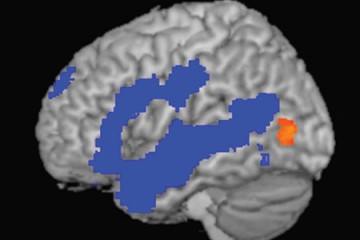Human babies and even animals have a basic number sense that many believe evolves from seeing the world and trying to quantify all the sights. But vision has nothing to do with it—Johns Hopkins University neuroscientists have found that the brain network behind numerical reasoning is identical in blind and sighted people.
The researchers also found the visual cortex in blind people is highly involved in doing math, suggesting the brain is vastly more adaptable than previously believed. The findings are published online in the journal Proceedings of the National Academy of Sciences.
"The number network develops totally independently of visual experience," said lead author Shipra Kanjlia, a graduate student in JHU's Department of Psychological and Brain Sciences. "These blind people have never seen anything in their lives, but they have the same number network as people who can see."
The researchers had congenitally blind people and sighted people wearing blindfolds solve math equations and answer language questions while having a brain scan. With the math problems, participants heard pairs of increasingly complicated recorded equations and responded if the value for "x" was the same or different. The participants also heard pairs of sentences and responded if the meaning of the sentences was the same or different.

With both blind and sighted participants, the key brain network involved in numerical reasoning, the intraparietal sulcus, responded robustly as participants considered the math problems.
Meanwhile, in blind participants only, regions of the visual cortex also responded as they did math. And the visual cortex didn't merely respond—the more complicated the math, the greater the activity in the vision center.
Also see
Although it had been thought that brain regions including the visual cortex had entrenched functions that could change slightly but not fundamentally, these findings underscore recent research that showed just the opposite: The visual cortex is extremely plastic and, when it isn't processing sight, can respond to everything from spoken language to math problems.
Co-author Marina Bedny, an assistant professor of psychological and brain sciences, says the findings here, taken together with earlier results, suggest the brain as a whole could be extremely adaptable, almost like a computer that—depending on data coming in—could reconfigure to handle almost limitless types of tasks. It could someday be possible to reroute functions from a damaged area to a new spot in the brain, she said.
"If we can make the visual cortex do math," Bedny said, "in principle we can make any part of the brain do anything."
This study is also the first to demonstrate that this repurposed vision center in blind people is not just responding to new functions haphazardly; the region has become specialized and segmented by function, like any other part of the brain. Some parts of the cortex are doing math, while other parts are doing language, etc. Even in a resting state, brain scans show these new brain regions connect to traditional parts of the brain responsible for math and language in sighted people.
Posted in Science+Technology










